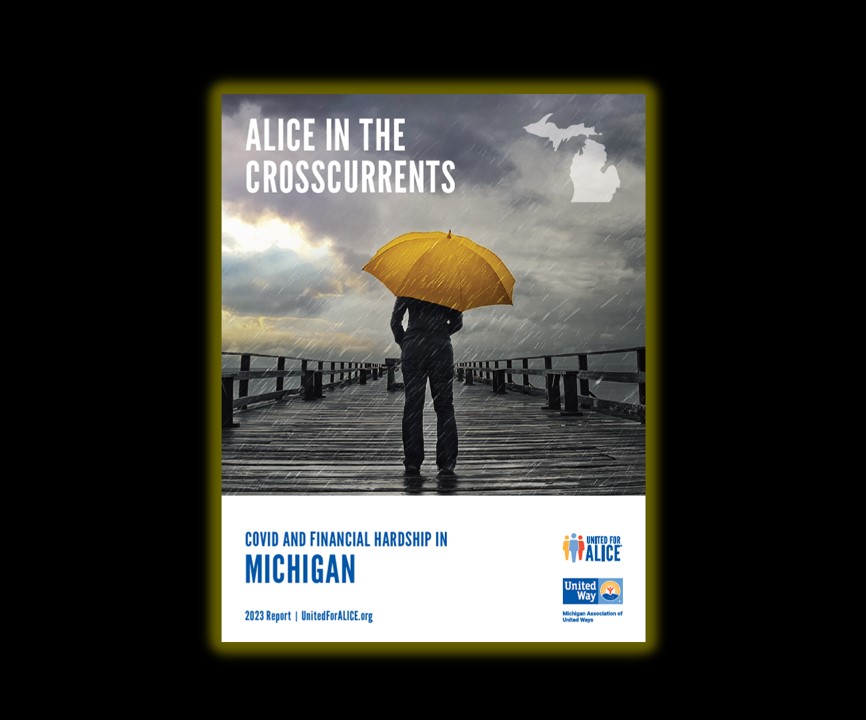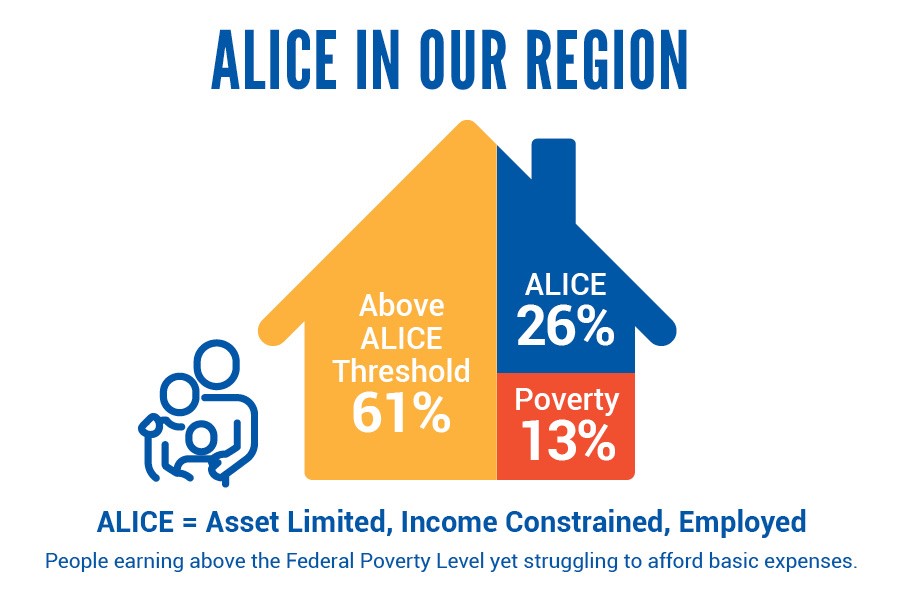
While aid programs during the COVID-19 pandemic likely eased financial stress on many households, the risk of more families struggling is rising, according to a new report on financial hardship in Michigan.
ALICE in the Crosscurrents: COVID and Financial Hardship, released today by Michigan’s United Way network and the research organization United For ALICE, shows 13% of households in our six-county region—and the state as a whole—live below the Federal Poverty Level, while another 26% struggle to make ends meet. People in the latter group are known as ALICE (Asset Limited, Income Constrained, Employed), earning above poverty but less than what’s needed to survive in the modern economy.

Those percentages from 2021 data are similar to what was found in the last ALICE report, issued two years ago with data from 2019. However, the actual number of households in our region that are either in poverty or ALICE grew an estimated 3%—meaning 162,795 households can’t keep up financially.
Michigan ranks 22nd in the United States for individuals and families struggling financially, according to the new report. Nearly 1.6 million households statewide—39%—fell below the ALICE Threshold
“This data puts a bold line under the financial peril that too many people face in our communities,” said Chris Sargent, President and CEO of United Way of South Central Michigan.
“ALICE families have been overlooked and undercounted by traditional poverty measures. ALICE is our local child care workers, home health aides, cashiers and many others heralded during the pandemic. They’re working low-wage jobs, with little or no savings and one emergency from poverty. We need to do better by these people whom we all count on,” Sargent added.
Some key findings from the report:
- In our six-county region, Calhoun and Jackson counties had the highest percentage of households in the ALICE range at 30% each. Ingham County had the highest percentage in poverty at 17%. Here are each county’s 2021 findings: Calhoun County, 30% ALICE, 12% poverty; Clinton County, 22% ALICE, 8% poverty; Eaton County, 23% ALICE, 9% poverty; Ingham County, 24% ALICE, 17% poverty; Jackson County, 30% ALICE, 12% poverty; Kalamazoo County, 26% ALICE, 15% poverty.
- In our region, an individual must earn at least $13.56 full time in order to meet monthly expenses—what’s called a survival budget. A family of four, with an infant and a preschooler, must earn at least $30.40 full time, even if both parents are working.
- Fourteen of the 20 most common jobs in Michigan paid less than $20 per hour in 2021. Among the jobs with the highest rate of workers living below the ALICE Threshold were cashiers (47%), personal care aides (46%), fast food/counter workers (42%) and cooks (40%). The median wage for any of those jobs did not exceed $13.77 an hour.
- Racial disparities persist in the rates of financial hardship: 61% of Black and 44% of Hispanic households in Michigan were below the ALICE Threshold in 2021, compared to 35% of white households. More than 1 in 5 Black households were in poverty.
- In 2021, 71% of single-female-headed households in Michigan were below the ALICE Threshold, compared to 51% single-male-headed households.
ALICE is our local child care workers, home health aides, cashiers and many others heralded during the pandemic. They’re working low-wage jobs, with little or no savings and one emergency from poverty. We need to do better by these people whom we all count on.
Chris Sargent, President & CEO, UWSCMI
As pandemic support programs begin to fade, concern is rising about how financial challenges will hit ALICE households.
“A positive change during the pandemic was that tax credits, stimulus payments and rental assistance were available for ALICE households and provided strong relief,” said Stephanie Hoopes, Ph.D., United For ALICE National Director. “However, as some of these supports come to an end, growing food insufficiency and other indicators reveal continued stress. Ignoring these warning signs places ALICE, our economy and the well-being of our communities at great risk.”
The success of a community is directly related to the financial stability of its members, yet ALICE families are making impossible decisions every day. Rent or utilities? Food or medicine?
Sargent said that UWSCMI’s impact work focuses on the needs of ALICE, especially racial and economic disparities.
“We believe that helping these working families find financial stability will benefit our local communities, our region and beyond,” he said.
The ALICE report is issued about every two years by the Michigan Association of United Ways, local United Ways and the research arm United For ALICE. Consumers Energy Foundation provides crucial funding for the study in Michigan.
Download the full report on Michigan here. Information on each of the counties in our region can be downloaded here. And you can learn more about ALICE by visiting our website, unitedforscmi.org/alice, as well as check our Facebook and Instagram pages for infographics and other details about ALICE over the next week. Finally, you’ll find an interactive dashboard covering state, county and local ALICE data unitedforalice.org/Michigan.










